User experience (UX) is a multifaceted concept that encompasses every interaction a user has with a product, service, or system. In the realm of web design, understanding UX is paramount, as it directly influences how users perceive and engage with a website. A positive user experience can lead to increased user satisfaction, higher conversion rates, and improved brand loyalty.
To grasp the intricacies of UX, designers must delve into the psychology of users, their behaviors, and their expectations. This involves conducting user research, gathering feedback, and analyzing user behavior through various metrics. One of the key components of understanding user experience is empathy.
Designers must put themselves in the users’ shoes to comprehend their needs and pain points. This can be achieved through methods such as user interviews, surveys, and usability testing. By collecting qualitative and quantitative data, designers can identify common challenges users face when navigating a website.
For instance, if users frequently abandon their shopping carts due to a complicated checkout process, this insight can drive design improvements that streamline the purchasing journey. Ultimately, a deep understanding of user experience allows designers to create websites that not only meet user needs but also exceed their expectations.
Key Takeaways
- Understanding the User Experience is crucial for creating a successful website.
- Utilizing Responsive Design ensures that the website looks and functions well on all devices.
- Implementing Clear Navigation helps users find what they are looking for easily.
- Incorporating Visual Hierarchy guides users’ attention to the most important elements on the page.
- Optimizing Page Load Speed is essential for keeping users engaged and satisfied with the website.
Utilizing Responsive Design
Responsive design is an approach that ensures a website’s layout and content adapt seamlessly to various screen sizes and devices. With the proliferation of smartphones and tablets, responsive design has become essential for providing an optimal viewing experience across all platforms. This technique involves using flexible grids, fluid images, and CSS media queries to create a fluid layout that adjusts based on the user’s device.
By employing responsive design principles, designers can ensure that users have a consistent experience whether they are accessing the site from a desktop computer or a mobile device. The benefits of responsive design extend beyond aesthetics; they also encompass functionality and usability. For example, a responsive website eliminates the need for users to zoom in or scroll horizontally to view content properly.
This not only enhances user satisfaction but also reduces bounce rates, as visitors are more likely to stay on a site that is easy to navigate. Additionally, search engines like Google prioritize mobile-friendly websites in their rankings, making responsive design a crucial factor for SEO. By adopting a responsive design strategy, businesses can reach a broader audience while improving their online visibility.
Implementing Clear Navigation
Clear navigation is a cornerstone of effective web design, as it directly impacts how easily users can find the information they seek. A well-structured navigation system allows users to move through a website intuitively, reducing frustration and enhancing their overall experience. To achieve this clarity, designers should focus on creating a logical hierarchy of information, using descriptive labels for menu items, and ensuring that navigation elements are easily accessible across all pages.
One effective strategy for implementing clear navigation is to employ a top-level menu that categorizes content into broad sections. For instance, an e-commerce website might have categories such as “Men,” “Women,” “Kids,” and “Sale.” Within each category, subcategories can further refine the options available to users. Additionally, incorporating breadcrumb navigation can provide users with context about their current location within the site, allowing them to backtrack easily if needed.
By prioritizing clear navigation, designers can significantly enhance user satisfaction and encourage visitors to explore more content.
Incorporating Visual Hierarchy
Visual hierarchy refers to the arrangement of elements on a webpage in a way that guides users’ attention and emphasizes important information. By strategically using size, color, contrast, and spacing, designers can create a visual flow that directs users toward key content areas. For example, larger headlines typically draw more attention than smaller text, making them ideal for conveying essential messages or calls to action.
Similarly, contrasting colors can highlight buttons or links that require user interaction. Incorporating visual hierarchy not only improves aesthetics but also enhances usability. When users can quickly identify the most important elements on a page, they are more likely to engage with the content effectively.
For instance, an online news site might use bold headlines and larger images to draw attention to breaking news stories while employing smaller text for less critical updates. This approach ensures that users can easily scan the page and find the information they are most interested in without feeling overwhelmed by cluttered layouts.
Optimizing Page Load Speed
Page load speed is a critical factor in user experience and overall website performance. Research has shown that users expect web pages to load within two seconds; beyond this threshold, the likelihood of abandonment increases significantly. Slow-loading pages can frustrate users and lead to higher bounce rates, negatively impacting both user satisfaction and search engine rankings.
Therefore, optimizing page load speed should be a priority for web designers and developers. Several strategies can be employed to enhance page load speed effectively. One common approach is to minimize file sizes by compressing images and utilizing efficient coding practices.
Additionally, leveraging browser caching allows frequently accessed resources to be stored locally on users’ devices, reducing load times for subsequent visits. Content Delivery Networks (CDNs) can also be utilized to distribute website content across multiple servers worldwide, ensuring faster access for users regardless of their geographic location. By prioritizing page load speed optimization, businesses can create a more enjoyable browsing experience while improving their chances of retaining visitors.
Focusing on Mobile Optimization
As mobile device usage continues to rise, focusing on mobile optimization has become increasingly important for web designers. A mobile-optimized website is designed specifically for smaller screens and touch-based navigation, ensuring that users have a seamless experience regardless of the device they are using. This involves not only responsive design but also considering factors such as touch targets, font sizes, and layout adjustments that cater specifically to mobile users.
One key aspect of mobile optimization is ensuring that interactive elements are easily accessible and usable on touchscreens. For instance, buttons should be large enough for users to tap comfortably without accidentally clicking adjacent links. Additionally, forms should be simplified for mobile users by minimizing the number of fields required and utilizing features like auto-fill where possible.
By prioritizing mobile optimization in web design, businesses can capture the growing segment of mobile users and provide them with an engaging experience tailored to their needs.
Prioritizing Accessibility
Accessibility in web design refers to creating websites that are usable by individuals with disabilities or impairments. This includes considerations for those with visual impairments who may rely on screen readers or those with motor disabilities who may use alternative input devices. Prioritizing accessibility not only ensures compliance with legal standards but also expands the reach of a website by making it inclusive for all users.
To enhance accessibility, designers should adhere to established guidelines such as the Web Content Accessibility Guidelines (WCAG). These guidelines provide recommendations for creating content that is perceivable, operable, understandable, and robust for all users. For example, using descriptive alt text for images allows screen readers to convey information about visual content to visually impaired users.
Additionally, ensuring sufficient color contrast between text and background elements improves readability for individuals with color blindness or low vision. By integrating accessibility into the design process from the outset, businesses can foster inclusivity while enhancing their overall user experience.
Integrating SEO Best Practices
Search Engine Optimization (SEO) is an essential component of web design that focuses on improving a website’s visibility in search engine results pages (SERPs). Integrating SEO best practices into the design process ensures that websites are not only visually appealing but also discoverable by potential visitors. This involves optimizing various elements such as meta tags, headings, URLs, and content structure to align with search engine algorithms.
One effective strategy for integrating SEO into web design is conducting keyword research to identify relevant terms and phrases that potential users are searching for. By incorporating these keywords naturally into page titles, headings, and body content, designers can enhance the likelihood of ranking higher in search results. Additionally, optimizing images with descriptive file names and alt text contributes to better indexing by search engines while improving accessibility for users with disabilities.
By prioritizing SEO best practices during the design phase, businesses can increase organic traffic and improve their online presence.
Streamlining Content Organization
Content organization plays a crucial role in how users interact with a website. A well-organized site allows visitors to find information quickly and efficiently while minimizing cognitive overload. To streamline content organization effectively, designers should focus on categorizing information logically and employing clear labeling systems that guide users through the site.
One approach to achieving streamlined content organization is creating an intuitive information architecture that reflects user needs and behaviors. This may involve grouping related content together under specific categories or topics while ensuring that navigation paths are straightforward and easy to follow. For example, an educational website might categorize resources by subject matter or grade level, allowing students and educators to locate relevant materials effortlessly.
By prioritizing streamlined content organization in web design, businesses can enhance user engagement and satisfaction while encouraging exploration of additional resources.
Utilizing High-Quality Imagery
Imagery plays a significant role in web design by enhancing visual appeal and conveying messages effectively. High-quality images can capture users’ attention and evoke emotions that resonate with their experiences or aspirations. However, it is essential to strike a balance between aesthetics and performance; large image files can slow down page load times if not optimized properly.
To utilize high-quality imagery effectively, designers should consider factors such as resolution, file format, and compression techniques. For instance, using JPEG format for photographs allows for high-quality visuals while maintaining relatively small file sizes compared to PNGs or GIFs. Additionally, incorporating images strategically throughout the site—such as hero images on landing pages or relevant visuals within blog posts—can enhance storytelling and create a more immersive experience for users.
By prioritizing high-quality imagery in web design while optimizing for performance, businesses can create visually stunning websites that engage visitors effectively.
Testing and Iterating for Improvement
The process of testing and iterating is vital in web design as it allows designers to gather feedback on usability and functionality before launching a site or making significant changes. User testing involves observing real users as they interact with the website to identify pain points or areas for improvement. This iterative approach enables designers to refine their work based on actual user experiences rather than assumptions.
A/B testing is one effective method used during this phase; it involves comparing two versions of a webpage to determine which performs better in terms of user engagement or conversion rates. For example, testing different call-to-action buttons—such as varying colors or wording—can provide insights into what resonates most with users. Additionally, gathering analytics data post-launch helps identify trends in user behavior over time, allowing for ongoing adjustments based on real-world usage patterns.
By embracing testing and iteration as integral components of the design process, businesses can continuously enhance their websites’ effectiveness while meeting evolving user needs.
If you are interested in learning more about web design construction, you may want to check out the article “Hello World: A Beginner’s Guide to Web Development”. This article provides valuable insights and tips for those just starting out in the world of web design. It covers everything from basic HTML and CSS to more advanced topics like responsive design and user experience. Reading this article can help you gain a better understanding of the fundamentals of web development and improve your skills in creating visually appealing and functional websites.
FAQs
What is web design construction?
Web design construction refers to the process of creating and building a website. It involves various elements such as layout design, content creation, coding, and testing to ensure the website functions properly.
What are the key components of web design construction?
The key components of web design construction include graphic design, user interface design, coding (HTML, CSS, JavaScript), content creation, and testing.
Why is web design construction important?
Web design construction is important because it determines the overall look, feel, and functionality of a website. A well-constructed website can attract and engage users, while a poorly constructed website can drive users away.
What are the best practices for web design construction?
Best practices for web design construction include creating a responsive design, optimizing for speed and performance, ensuring accessibility for all users, and testing across different browsers and devices.
What are some popular tools and technologies used in web design construction?
Popular tools and technologies used in web design construction include Adobe Photoshop for graphic design, Adobe XD for prototyping, HTML/CSS/JavaScript for coding, and content management systems like WordPress or Drupal.
What are some common challenges in web design construction?
Common challenges in web design construction include ensuring cross-browser compatibility, optimizing for mobile devices, creating a user-friendly interface, and maintaining consistency across different pages of the website.


